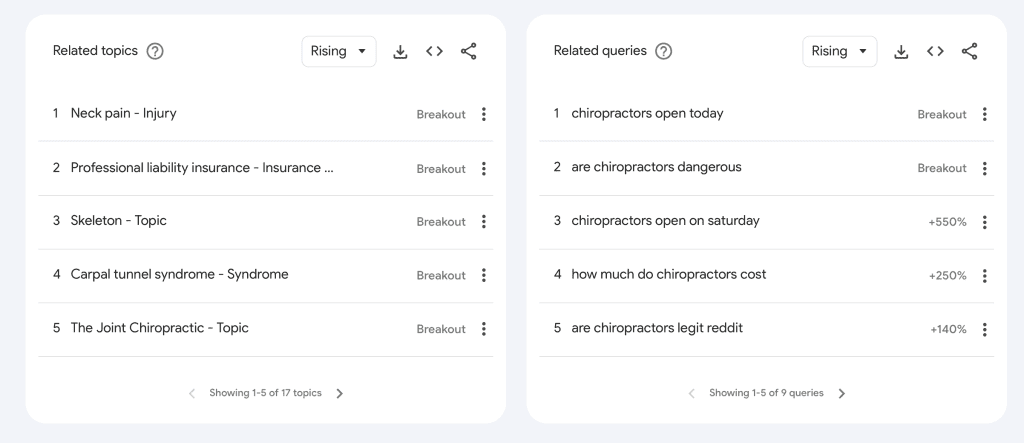If you’re a small business owner you probably use your email list a ton (hopefully). You’re sending out product updates, asking for reviews, letting people know about deals and promos and more.
One of my favorite marketing quips is ‘The Money is in the List.’
But here’s the kicker. People join that list through visiting your website. And this is twofold: 1) If there isn’t traffic to your website, your list isn’t growing and 2) If what you say on your website isn’t valuable, your list isn’t growing.
So, let’s talk about the holy grail of marketing: traffic. Because, let’s face it, without traffic, you’re not getting anywhere.
How are the small business owners we work with are using content to get more organic traffic without increasing their marketing budget? Here’s a few things we’ve coached them on to grow their traffic.
1. Ask the right questions.
You’re an expert in your field! Don’t forget that.
Use your knowledge to address the queries your audience might have. Create content – articles, videos, or podcasts – that provides insightful answers. This approach will draws your audience to your website because you are answering the questions that they are asking right now.
But how do you know what questions to ask?
So, full disclosure, agencies usually have subscriptions to tools that track trends for different industries and discover the questions people are typing into Google. But you don’t need those premium tools to tackle most of these questions.
- Just type ‘your industry – how to’ into Google’s search bar and see what comes up! This is a quick way to see what types of questions are actively being searched.
- One of my faves. Go to Google Trends and type in your industry or job. It’ll provide a ton of data on what people are searching for as it’s related to your industry. Here’s a great example from searching for Chriopractors (one of our favorite industries to work with!).
- Chat with your customers a little more. Send out a survey to your current email list with a little promo. While you’re on a job or in the shop ask them questions. When you have client intake, what questions are you asking? Could any of those be a video on social?

2. Make it Easy to Navigate
I like to think of my content as a clean, organized garage.
We recently just purged our garage. Like, hardcore purge. I remember walking in a few times to ‘maybe’ start the work, and I was so overwhelmed I decided to work instead.
Ya, my garage was so unorganized I chose work over cleaning it.
I had no idea where my tape measure was, some of the yard tools were with the carpentry tools and there were weight lifting wraps in a bin I keep drill attachments in. No clue how they got there, but it was hard to find anything.
That’s kind of how an unorganized website feels in general, but when you add your content into the mix it makes it harder for visitors to find their way around.
By categorizing your content effectively, you make it easier for visitors to find what they need, encouraging them to return. Spend some time sorting your content into clear categories to enhance user experience.
Start by categorizing your content. Here’s an example of ours.
- Websites
- Digital Marketing
- Local SEO
- Lead Generation
- Paid Ads
- Social Media
That’s it. This simple strategy gives us a plan for the kinds of content we make that we typically don’t deviate from.
Stay in your lane when it comes to the content you make. Staying in your lane is how you establish yourself as an authority and invite people to associate you with being an authority in whatever space you’re in. Does that mean you can’t have fun, random posts sometimes? Not at all, but the lion’s share of your content both on social and on your website should be connected back to the content organization structure you decide on.
3. Decide to Be Consistent
Managing multiple tasks can be challenging, but having a content plan is essential for your website’s success. Create a content calendar and adhere to it. Regular and consistent content keeps your audience engaged and helps in building a loyal following.
Can I be honest. I fall short here all the time.
Tons of digital marketers are like the starving baker, always working on other peoples projects but never baking ourselves any bread. I get it!
Here’s the secret sauce.
If you map out your content, and already have your thoughts brewing, it becomes so much more manageable.
Let’s say you want to make two blogs and two short YouTube videos every month. That means you only need to determine 52 questions you want to answer for the entire year to accomplish that plan.
Use the tools we shared above, spend an hour or two writing those questions and maybe a few ideas to expand on in the doc you made, maybe even get some help from AI to script your videos. It’s doable. You CAN do it.
Are you doing cool things in your community this year? Write about it.
Are you launching a product in a three months? Video content.
Did you get the opportunity for your business to be a part of something? Share the story.
4. Just Be Yourself
You don’t need to be a professional writer; your voice is your strength. Be genuine in your content, and let your personality come through. This authenticity creates a stronger connection with your audience.
Look, I’m addicted to TikTok, but the beauty of TikTok is that it isn’t a polished platform. It’s real life for the most part and personality driven. I bet you’re watching stuff on social media too…and I bet you find that you identify best with people who are honestly just being themselves.
Just like you can spot BS a mile away, so can your audience. So lean into the fact that people love authenticity over pretty much everything, be yourself and make stuff that comes from you.
5. Track Everything
Use tools like Google Analytics to track your content’s performance.
This data helps you understand what resonates with your audience and what doesn’t, allowing you to refine your strategy based on actual performance metrics. If your content is getting in front of people and people are responding, kudos. If it’s in front of people and it’s not resulting in traffic, you need to find out what can be tweaked to change that.
Is the quality of what you’re sharing on social media lacking? Is the audio quality of the video you put on YouTube not good? Those are easily fixed things. Use a template on Canva to start making social media posts and buy a Rode mic to handle your audio. Voila.
Now, I get it. That’s an oversimplification. But you get the gist. You make the content. Track the content. And tweak your strategies based on the traction of the content.
Wrapping up
Now that people are visiting your site, you’re going to need a lead generation system to capitalize on it! Offer a discount for first time buyers, create a free guide for something to do with your industry, something that people can opt into with their email and name. Why? Because the money is in the list, and hopefully these tips help you drive traffic, which drives list growth, which drives sales.
You got this!
And even though you’ve got it, if you need a little help and just want to see where we could come alongside you and help, we got you too!

